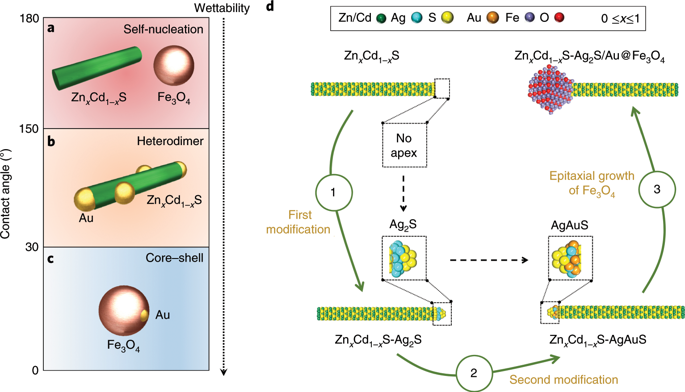Nature Nanotechnology ( IF 38.1 ) Pub Date : 2020-01-20 , DOI: 10.1038/s41565-019-0606-8 Tao-Tao Zhuang 1, 2 , Yi Li 1 , Xiaoqing Gao 3, 4 , Mingyang Wei 2 , F Pelayo García de Arquer 2 , Petar Todorović 2 , Jie Tian 5 , Gongpu Li 1 , Chong Zhang 1 , Xiyan Li 2 , Liang Dong 1 , Yonghong Song 6 , Yang Lu 6 , Xuekang Yang 3 , Libing Zhang 7 , Fengjia Fan 8 , Shana O Kelley 7, 9 , Shu-Hong Yu 1 , Zhiyong Tang 3 , Edward H Sargent 2

|
Chirality—the property of an object wherein it is distinguishable from its mirror image—is of widespread interest in chemistry and biology1,2,3,4,5,6. Regioselective magnetization of one-dimensional semiconductors enables anisotropic magnetism at room temperature, as well as the manipulation of spin polarization—the properties essential for spintronics and quantum computing technology7. To enable oriented magneto-optical functionalities, the growth of magnetic units has to be achieved at targeted locations on a parent nanorod. However, this challenge is yet to be addressed in the case of materials with a large lattice mismatch. Here, we report the regioselective magnetization of nanorods independent of lattice mismatch via buffer intermediate catalytic layers that modify interfacial energetics and promote regioselective growth of otherwise incompatible materials. Using this strategy, we combine materials with distinct lattices, chemical compositions and magnetic properties, that is, a magnetic component (Fe3O4) and a series of semiconducting nanorods absorbing across the ultraviolet and visible spectrum at specific locations. The resulting heteronanorods exhibit optical activity as induced by the location-specific magnetic field. The regioselective magnetization strategy presented here enables a path to designing optically active nanomaterials for chirality and spintronics.
中文翻译:

半导体纳米棒中的区域选择性磁化
手性——一个物体的属性,它可以与它的镜像区分开来——在化学和生物学中引起了广泛的兴趣1,2,3,4,5,6。一维半导体的区域选择性磁化可在室温下实现各向异性磁性,以及控制自旋极化——自旋电子学和量子计算技术所必需的特性7. 为了实现定向磁光功能,必须在母纳米棒上的目标位置实现磁性单元的生长。然而,在具有大晶格失配的材料的情况下,这一挑战尚未得到解决。在这里,我们通过缓冲中间催化层报告了独立于晶格失配的纳米棒的区域选择性磁化,该中间催化层改变了界面能量学并促进了其他不相容材料的区域选择性生长。使用这种策略,我们将具有不同晶格、化学成分和磁性的材料组合在一起,即磁性成分(Fe 3 O 4) 和一系列在特定位置吸收紫外线和可见光谱的半导体纳米棒。由此产生的异质纳米棒表现出由位置特异性磁场诱导的光学活性。这里提出的区域选择性磁化策略为设计用于手性和自旋电子学的光学活性纳米材料开辟了道路。











































 京公网安备 11010802027423号
京公网安备 11010802027423号